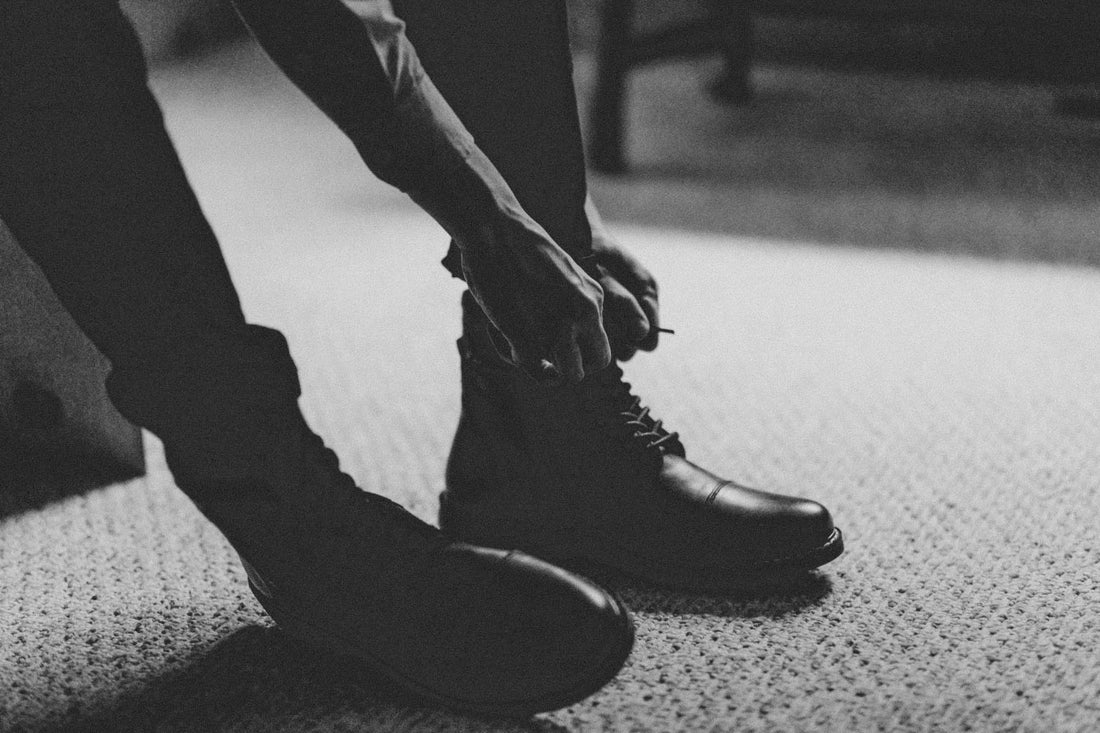A man doesn’t need a wall of footwear; he needs a tight rotation that’s impeccably made and properly maintained. A five-pair arsenal covers almost every scenario:
-
black cap-toe oxfords
-
dark brown plain-toe derbies
-
a mid-brown penny loafer
-
a sleek Chelsea or chukka boot
-
a bad-weather boot with a rubber sole
That’s it. With those, you can move cleanly from boardroom to bar, wedding to weekend. The trick is construction: buy pairs that can be resoled and repaired. Do that, and over ten years “expensive” becomes downright economical.
What “Quality” Really Means
Welting and Why It Matters
Goodyear welt (GYW). The classic. A strip of leather (the welt) is stitched to the upper and insole; the outsole is then stitched to that welt. The cavity created is usually filled with cork, which beds to your foot over time. The result: structure, water resistance, and easy resoling—again and again. The method dates to an 1869 patent by Charles Goodyear Jr., and it’s prized for durability and serviceability. Wikipedia
Blake stitch. Sleeker and more flexible. The outsole is stitched directly through the insole and upper from the inside. That creates a trimmer waist and lighter weight, but it’s less water-resistant because stitch channels can admit moisture; resoling is possible but requires the right machinery and a skilled cobbler. StridewiseBeckett Simonon
Blake Rapid. A hybrid that adds a separate midsole and an external stitch to the outsole—more robust and more water-resistant than standard Blake, still slim in profile. Think of it as Blake with a safety harness. Stridewise
Hand-welted / Norwegian (Norvegese). Heavy-duty craft with visible external stitching and outstanding weather protection; you’ll see it on alpine-leaning footwear and statement make-ups. Overkill for an office oxford; perfect for a storm. poyter.comHeddels
Bologna (a.k.a. sacchetto). A “bag” construction—supple and glove-like, often used on loafers or dress slippers where flexibility and comfort are the point. Not for trenches and monsoons; excellent for long dinners and travel. FindSourcingsantosshoes.com
If all that sounds academic, boil it down to this: if you want maximum lifespan and easy resoles, go welted (Goodyear or hand-welted). If you want sleekness and softness, consider Blake or Bologna, and treat them as fair-weather friends. Heddels

Soles: Leather vs. Rubber (and Which Rubber)
Leather soles are elegant, breathable, and quiet under a tux. They glide across carpet and marble but can be slippery and wear quickly on gritty pavements. For pure formality, leather still wins.
Rubber soles bring grip and longevity. The gold standard on dress-capable shoes is Dainite, a studded British sole from Harboro Rubber—durable, relatively low-profile, and discreet enough for tailoring. Other patterns like Ridgeway and Medway offer stronger lugs. Choose them when rain is likely or streets are rough. Dainite+2Dainite+2
For real weather, commando (deep lug) outsoles bite into muck; crepe is cushy but can feel ungainly in heat; wedge soles ride comfortable and casual. Result: leather for black tie and high ceremony, studded rubber for most city life, commando for foul play by the elements. SamTalksStyle
When to Wear What (and Why)
-
Black cap-toe oxford (leather sole or slim Dainite): Interviews, funerals, black-tie-adjacent events. A leather sole is traditional; studded rubber is acceptable in bad weather if the profile stays trim.
-
Dark brown plain-toe derby (Dainite or leather): The everyday suit shoe. Travels well, dresses down with flannel or cotton chinos.
-
Mid-brown penny loafer (leather or thin rubber): Business casual, travel days, smart dinners. With socks, conservative; without, rakish (mind the dress code).
-
Chelsea or chukka boot (Dainite): Autumn through spring, with tailoring or dark denim. Keep the silhouette sleek; you want a dress boot, not a farm implement.
-
Bad-weather boot (commando or Ridgeway): Rain, sleet, cobbles, and questionable pavements. Keep uppers clean and polished; the aggression stays underfoot. Dainite
Classics vs. Designer: The Diplomatic Option
Designers will happily sell you a mood: exaggerated lasts, logos the size of small islands, soles that belong on lunar modules. There’s fun in that—dress is play, after all—but if you want longevity in both construction and relevance, stick to the canon:
-
Oxford cap-toe: the navy suit of shoes.
-
Plain-toe derby: adaptable, forgiving, reliable.
-
Penny loafer: the most useful smart-casual shoe a man can own.
-
Wholecut oxford: sleek, minimal, very evening.
-
Chelsea/chukka: the elegant boot.
When in doubt, select the version a traditional shoemaker could have produced in 1965 and would still produce today. Fashion cycles; good lasts don’t. Even the fashion press has noticed the return to classics and their resale-friendly longevity. The TimesGQ
Best Value: Brands That Earn Their Keep
Value isn’t just price—it’s how much shoe you get for the pound or dollar, how serviceable it is, and how easy it is to live with. Below are illustrative picks across price tiers, with public sources you can check. Prices shift, models change; focus on construction, materials, and service.
Entry / “First Goodyear Welt” (~$200–$300)
-
Meermin (Mallorca). Frequently cited as the most affordable way into genuine GYW dress shoes. Expect a firm break-in and clean designs; quality has improved steadily, and resoling is straightforward. Superb starting point if you’ll rotate and maintain. The Shoe Snob BlogHeddelsDappered
-
Beckett Simonon. Mostly Blake, made-to-order. Polished finishing for the price; you exchange lead time for savings. Their own primer on Blake vs. Goodyear is balanced enough to read before buying. Beckett Simonon
-
Thursday Boot Co. (select models). Known more for boots, but an approachable path into GYW construction and hard-wearing rubber soles if your life is more pavements than parquet. Their Goodyear explainer is useful 101-level reading. Thursday Boot Company
Mid-Tier “Buy It Once, Wear It Hard” (~$300–$500)
-
Grant Stone. Strong finishing, stout builds, excellent leathers, honest pricing; repeatedly lauded by boot and shoe reviewers for value well above cost. A sweet spot for loafers, derbies, and service boots you’ll actually wear. StitchdownHe Spoke StyleStridewise
-
Carlos Santos / J.FitzPatrick / Loake 1880. European stalwarts offering handsome lasts and real welted construction at sane prices. The Shoe Snob’s round-ups spotlight models that punch above their class. The Shoe Snob Blog
-
Allen Edmonds (on sale). American classic with a factory Recrafting program. When discounted, models like Park Avenue, Strand, and Fifth Avenue deliver breadth of sizes/widths and reliable serviceability for decades. allenedmonds.com
Upper Mid / Heritage Makers (~$500–$900)
-
Crockett & Jones. Long recommended as the benchmark of English RTW value: refined lasts, consistent QC, and a catalogue that rewards patience. If you buy one “forever” loafer, their Harvard or Boston is a prime candidate. Permanent Style
-
Alden. Iconic for shell cordovan and sturdy lasts; priced accordingly, but the durability and resoling culture create true long-term economy—when you’ll wear them for decades. Recent mainstream guides even frame Alden as the premium end of a value spectrum. The Wall Street Journal
-
Tricker’s / Cheaney. Northampton workhorses—country boots, sturdy derbies, storm welts—ideal if your city has weather. Cheaney’s own technical notes on constructions like Veldtschoen explain why their bad-weather shoes perform. cheaney.co.uk
How to buy smart: choose standard colors (black, dark brown, mid-brown), standard models (cap-toe oxford, plain-toe derby, penny loafer, Chelsea/chukka). Those keep their value, recraft predictably, and pair with wardrobes you’ll still wear in ten years. When in doubt, avoid novelty; it almost always depreciates faster than leather.
A Quick Construction & Sole Cheat Sheet
-
GYW, leather sole: maximum formality; resolable; less grip. Weddings, interviews, solemn occasions. Wikipedia
-
GYW, Dainite sole: city all-rounder; discreet grip; wet-street insurance. Dainite
-
Blake, leather sole: sleek and flexible; fair weather; great for travel and dinners. Stridewise
-
Blake Rapid, rubber sole: slim look with more weather tolerance; good for smart-casual boots/shoes. Stridewise
-
Norwegian / storm welt, rugged rubber: maximum weather sealing; country boots, foul weather. poyter.com
-
Bologna (sacchetto): slipper-like comfort; loafers and dress casual; dry days. FindSourcing
Maintenance: Where Value Is Actually Made
Rotation: Don’t wear the same pair two days running. Give the cork and leather time to dry and rebound. (If you’ve invested in GYW, let it work.)
Trees: Cedar shoe trees prevent creasing and odor; they also keep the last’s shape longer.
Polish and condition: Every 8–12 wears for city shoes; more often for bad-weather boots. A light cream for nourishment, a wax for the cap and heel counters.
Resoles and repairs: If the upper is sound, don’t hesitate. That’s the point of welting. Some brands will do it in-house—Allen Edmonds’ Recrafting is the poster child—or you can work with a reputable cobbler. allenedmonds.comallenedmondsrecrafting.com

Building the Five-Pair Arsenal (and When to Deploy It)
-
Black Cap-Toe Oxford (GYW, leather sole)
The suit shoe. Wear with charcoal, navy, black tie optional (if you don’t own patent pumps). Keep the toe modest, the last elegant. Resolve before you burn the welt stitch. Wikipedia -
Dark Brown Plain-Toe Derby (GYW, Dainite)
Your workhorse. Travels well, takes rain, looks right with worsted, flannel, and cotton. Invest here and your other shoes live longer. Dainite -
Mid-Brown Penny Loafer (Blake or GYW, thin sole)
A Swiss-army shoe for modern offices and weekends. Pair with hopsack and oxford cloth, polo and chinos, even a tropical-weight suit. If you’re new, look at value standouts like Meermin or Grant Stone; if you want once-and-done, Crockett & Jones or Alden. HeddelsThe Wall Street JournalPermanent Style -
Chelsea or Chukka Boot (GYW, Dainite)
The sharp boot. Clean vamp, close ankle, no clunky sole. Works with denim and tailoring alike, and laughs at wet pavements. Dainite -
Bad-Weather Service Boot (GYW/Blake Rapid, lug or Ridgeway)
Days when the forecast is unprintable. This is the moment for Grant Stone-type builds or Northampton country specialists. Dress the upper, let the sole do the dirty work. StridewiseDainite
Buying Tactics That Save Real Money
-
Buy standard models in core leathers. Factories make more of them; discounts and seconds are easier to find.
-
Fit over brand. A well-fitted $300 shoe beats a mis-sized $800 shoe every time.
-
Learn last families. If you like a maker’s 65 last (AE) or 325 (C&J), stay near it. Comfort and silhouette are 80% of elegance.
-
Audit your wardrobe. The best value pair is the one that earns 50 wears a year.
-
Service early. Don’t wait until you’ve chewed through welts; a timely half-sole or heel block is cheap insurance.
Designer vs. Classic: The Final Verdict
Can you buy the big-logo, foam-platform, neon-soled statement? Of course. Will you want to in five years? Unclear. Better to make a quiet entrance: cap-toe, penny, Chelsea. The press may call it a “return” to dress shoes; traditional shoemakers never left. Classics win because they’re useful—they handle today, tomorrow, and the next promotion with equal poise. GQThe Times
A Short List to Start With
-
First dress shoe: Meermin classic cap-toe oxford. Honest welt, fair price; break-in, then bliss. The Shoe Snob BlogDappered
-
First loafer: Grant Stone penny (if you like substance) or Meermin (if you like price). Stitchdown
-
First boot: Grant Stone service boot or a Northampton maker on Dainite. StridewiseDainite
-
One-and-done upgrade: Crockett & Jones Harvard/Boston; pay once, care well, resole as needed. Permanent Style
-
USA evergreen: Allen Edmonds Park Avenue or Strand—especially compelling when you factor in factory recrafting. allenedmonds.com
Closing: The Mission Profile
A small wardrobe of serious shoes outperforms a large one of novelties. Learn the constructions. Select sensible soles. Choose models that have been correct for half a century and will be correct for the next. Then maintain them. Do this, and every step feels deliberate—quiet confidence underfoot, unbothered by weather or trend.
If you’d like, tell me your typical week (office formality, climate, walking mileage). I’ll tailor a five-pair loadout to your life—clean, efficient, and built to last.

